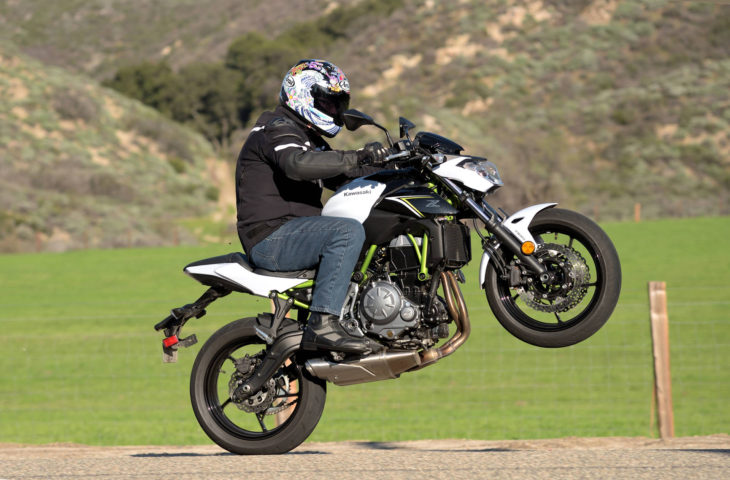
This is our final report on the 2017 Kawasaki Z650 ABS that we have been testing. You can look back at Part One of this report, as well as the press launch story for more background and details.
Recapping some of the technical specifications, although Kawasaki has produced a 649cc parallel twin powered bike in various guises for several years, the new Z650 is almost a ground-up redesign weighing approximately 40 pounds less than the previous, similar model. With a claimed curb weight (4 gallon gas tank topped off) of 406 pounds for the non-ABS version and 410 pounds for the ABS model, Kawasaki has essentially brought the weight of the Z650 equal to that of Yamaha’s excellent FZ-07.
The suspension has been re-tuned, but remains largely non-adjustable (only spring preload on the shock), and the brake calipers are new. The rear shock now benefits from a linkage system for more progressive action, and the front two-piston calipers are a new design from Nissin utilizing a modern ABS system (Bosch 9.1M) that keeps weight down and remains largely invisible to the rider (on the ABS model, of course). Front brake discs are 300 mm in diameter. The new front calipers have larger 27 mm pistons claimed to improve brake feel.
Kawasaki thankfully resisted the temptation to fit an oversize rear wheel and tire in favor of a smaller/lighter cast wheel holding a 160/60 x 17 Dunlop Sportmax D214. A similar five-spoke aluminum front wheel holds the same tire model in a standard 120/70 x 17 size.
A big part of the weight loss this year, and important to the Z650’s excellent handling (more about that below), is an entirely new high-tensile steel trellis frame with “optimized dimensions and wall thicknesses” – according to Kawasaki. The engine, and even the foot peg stays, serve as stressed members of the chassis further reducing weight. A “Gull-wing” swingarm is also new this year and, again according to Kawasaki, contributes to improved handling and allows clearance for the tightly tucked muffler.
The engine in the new Z650 is a refined version of the parallel-twin first introduced by Kawasaki back in 2005 in the Ninja 650R. I still recall being told at that press launch that the 650 engine was smaller and lighter than the parallel-twin found in the Ninja 500. It remains a modern design with fuel injection and DOHC four-valve heads, together with a relatively large bore and short stroke. The engine itself is narrow, allowing Kawasaki to build a chassis around it that keeps the rider’s feet and legs tucked in nicely.
For the new Z650, Kawasaki has made several changes to the engine, primarily designed to improve low-to-mid-range power. These include new cams, intake port shape, airbox design and exhaust system. Together with a 180° crank, Kawasaki includes a balancer shaft to smooth things out.
Also new on the Z650 is an “Assist and Slipper” clutch which increases compression of the clutch plates during acceleration without requiring the use of stiffer springs. This results in a very light clutch pull. A slip function is also included to prevent wheel lock-up when aggressively down-shifting.
The ergonomics of the Z650 are similar to many modern naked bikes. The seating position is upright with a slight lean forward to the bars. Legroom is reasonable, and the pegs are perhaps a bit rearward compared to some of the other bikes in the category. Not as upright and roomy as most adventure touring machines, but still comfortable for a long day in the saddle (which we found offered good support and shape).
The seat height is relatively low, offering shorter riders an easy reach to the ground. Average-sized riders can flat-foot at stops. The bike is relatively narrow between your legs.
As you pull away from a stop for the first time, you realize clutch pull is light and its engagement is precise. You can feather the clutch and make it do what you want it to do without any drama. Good low-end power also aides leaving a stop.
We suspect that peak horsepower is down slightly from the prior model, and the new Z650 does not seem to have quite the rip at higher rpms. At the same time, power lower on the tach seems to be clearly stronger, and this is where you need it most when riding on the street.
The Z650 doesn’t fall flat on top … it still revs strong to redline. The power bias just seems to have been shifted a bit to the middle of the tachometer. Together with the significant weight reduction, the Z650 feels very responsive at street rpm levels.
Fuel injection tuning is excellent, and transitions from a fully closed throttle are quite smooth and predictable. This is a particular advantage when exiting a corner from a big lean angle and rolling on the throttle as you stand up the bike. This aids grip and confidence.
We were somewhat surprised by the stock Dunlop Sportmax D214 tires. They may not feel as soft and sticky as pure sport rubber, but they provided good feedback and consistency. Grip levels were also excellent in the dry weather experienced while testing. Feedback from the contact patches, in our opinion, is also greatly enhanced by the new frame.
With so many modern bikes featuring extruded aluminum beam frames, we were very curious to see what it was like to ride the new Z650 with its steel trellis design. Handling and feedback come from the whole package, i.e., frame, suspension, tires, etc., but we are confident that Kawasaki’s new frame design contributed greatly to the impressive handling and feedback of the new Kawasaki Z650.
One ride in particular sticks in our mind. We took the Z650 to Mt. Palomar nearby to ride up and down the twisty switchbacks so popular with weekend sportbike riders. As I developed a rhythm on the Z650, it offered great confidence, and outstanding performance, on this very tight, somewhat technical mountain road.
I don’t normally do this, but here is a direct quote from notes I made immediately following this day on the Z650:
“Just got back from Palomar on the Z650. Fantastic ride and a fantastic bike. The engine is really strong in the mid-range, and even down low. It runs well into the upper mid-range and then hits the rev limiter. The engine also makes great sounds. The chassis really provides a lot of feedback, presumably because it is a steel frame, not aluminum. The suspension surprised me, as well. At first, I thought that the fork was a little bit too soft when riding aggressively and dove on the brakes. But I didn’t feel this after a while. The front brake is really strong and it never faded. The front brake is very surprising for this category of bike. The suspension is not the greatest, but it actually absorbed bumps pretty well. On the very rough Rice Canyon, I was able to carry a lot of speed without getting bounced around.”
No, I don’t normally feel quite so enthusiastic about a test bike after a ride like this. These are roads (Mt. Palomar and Rice Canyon) that I know pretty well, so I know what to expect. The Z650 surprised me. The front brake is really quite strong for this category of motorcycle. Feedback from the front brake is not the greatest, but it is far from “wooden”. Stopping power is excellent, however, and despite riding the bike where front brake fade could easily be noticeable, I never experienced any.
Basically, at my skill level (yours might be higher or lower), 650s in general, and the Z650 in particular, can provide a street riding experience where you feel you are getting the most from the machine, but that the machine’s limits are not holding you back. The Z650 changes directions almost effortlessly (aided in part by the narrower rear tire), but never felt unstable.
The six-speed transmission, given the torquey power delivery, offers at least one gear for every occasion and sixth gear leaves revs at a comfortable level without feeling like a true overdrive. The clutch slips just enough when aggressively downshifting to keep the rear tire planted on the tarmac.
The new instrument panel is very legible and provides as much information as you need, including a gear position indicator. The analog-style tachometer is much easier to read than many digital tachs. Fuel consumption information (not just fuel level) is another useful feature found on the Z650.
The Z650 is an excellent motorcycle. No qualifications are necessary when stating this (such as “budget bike”). It illustrates how far manufacturers have come with regard to the design of reasonably priced middleweight twins. This remains an engine size that can appeal to riders of all skill levels, and Kawasaki has wrapped it in a chassis that will satisfy both commuters and canyon carvers.
The 2017 Z650 ABS is priced at $7,399 ($6,999 without ABS). There are two color choices, including Pearl Flat Stardust White/Metallic Spark Black (our pictured test unit) and Metallic Flat Spark Black/Metallic Spark Black. Take a look at Kawasaki’s website for additional details and specifications, as well as a description of accessories available for this model.
See more of MD’s great photography:
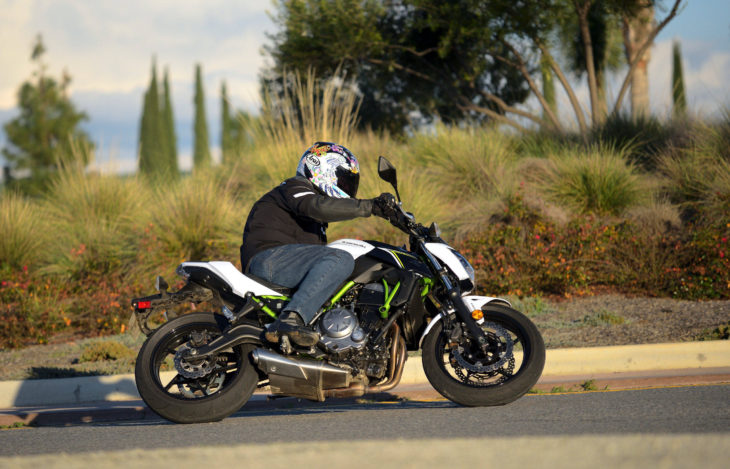
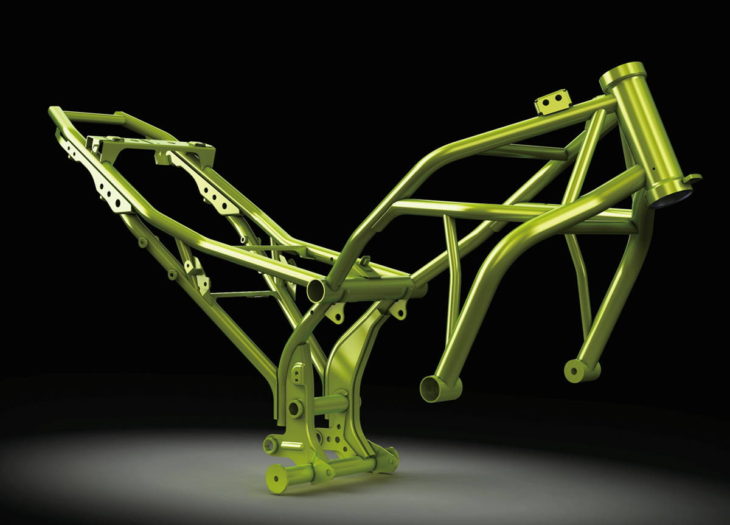
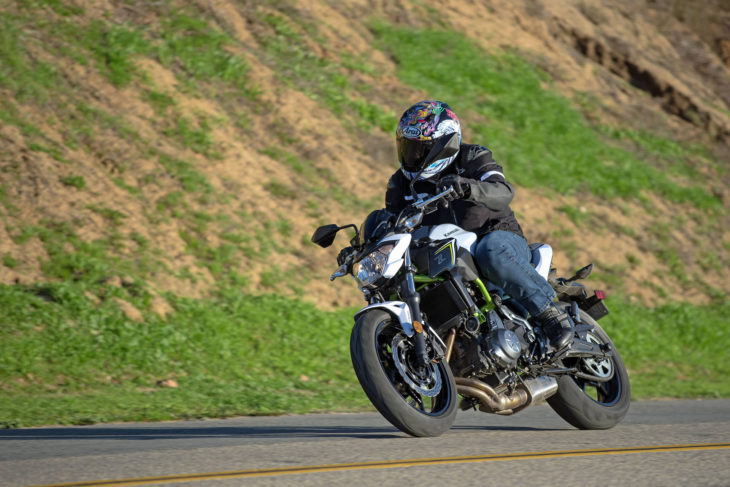
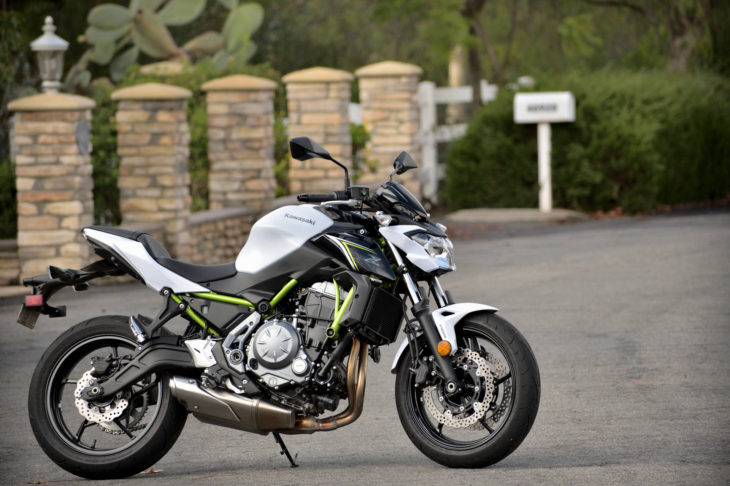
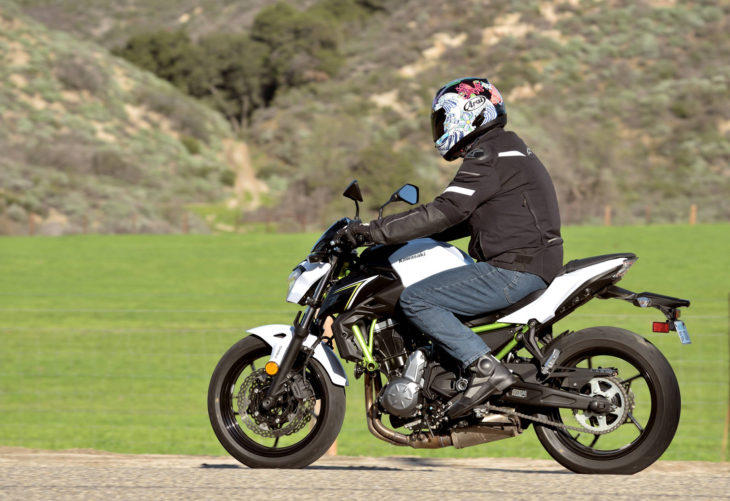


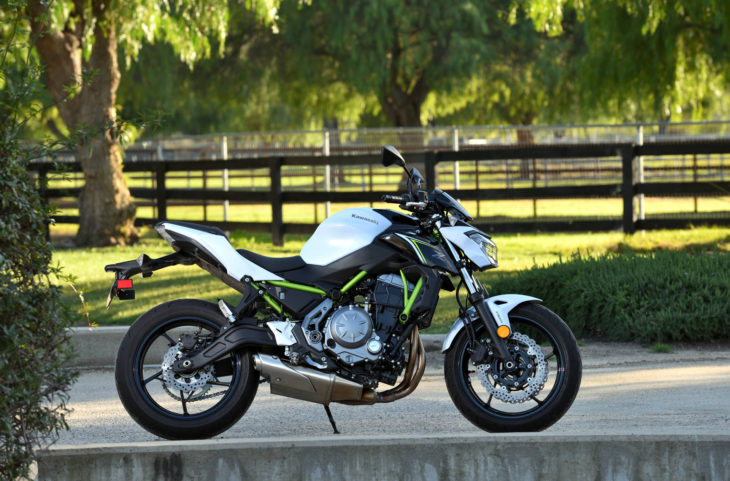






This, the FZ-07 and the SV 650. The UJM lives! Nice time to be a biker. It’s a shame I have so little money!
Interesting to me in that Kawasaki was always known as the performance manufacturer, yet this bike is down around 10 hp ( which is a lot … Nearly 15%) on it’s rivals, the Yamaha FZ-07 and Suzuki SV 650. According to Riders dyno 60.6 hp@8100 rpms and 43.9 torque @ 6700 rpms.
Did they dyno all 3 on the same day? MCN says the differences are smaller, and I dont see a comparison of midrange power, just peak horsepower.
Motorcycle.com tested the new SV vs FZ vs 690 Duke. Gabe was a rider in the test. They produced dyno charts for those bikes.
Peak HP’s: Suzuki 70.8@8600 FZ 69.8@9000 (Z650 from Riders dyno 60.6@8100)
Peak torque: Suzuki 44.9@6500 FZ 48@ 6500 (Z650 from Riders dyno 43.9@6700)
I’m just providing numbers that have been printed for comparison. Will be interesting to see a comparison test of the three. Like I said earlier though, on the road, dyno’s don’t mean squat. They only give an indication of how something should feel like power wise. Not how comfortable or easy to live with, or how good they handle, or how good the brakes are or how annoying the vibrations, or the quality of the fit and finish. The most important things when evaluating a motorcycle IMO. It’s why I generally buy Hondas. They may lose on the dynos, but win in the real world for me
Btw Hondas NC 700 gets slayed on hp on the dyno at 47.7 @6400 rpm but has torque similar to those above only at much lower rpm 42.6 @ 4700 rpms
Be nice if the NC made 60 something hp but it is so limited in rpms it can’t get close..
Dirk they (Rider mag) were just testing the 650 Kaw, I googled dyno tests on the other 2, and they were like 69 hp and 70 hp. We all know dyno readings can vary by day and by dyno, but the difference seemed rather significant regardless.
That’s not to say the Kaw is not a perfectly good motorcycle. There is more to a motorcycle than how it rates on a dyno. One of my rides is the CB1100 which doesn’t dyno very high either and it’s a great motorcycle IMO.
I was just surprised given Kaws reputation, that the Z650 was so far behind the Yam and Suz, going strictly by the numbers.
It’ll be interesting to see how the market reacts. TO a lesser degree, Kawasaki has made the same decision as Honda with their NC700, sacrifice the highest HP, hoping that the target rider / customer appreciates the difference in real-world usability that comes with it..
What’s sad is that I had to get so old before rational applications of technology started to really be applied to street bikes.
I think that the industry is starting to realize that most of the cult bikes have lovable torquey, feisty engines. I think it’s about what you want in a fun street bike. Keep the weight down, don’t get all OCD about chasing the last few horsepower, and make a bike that looks decent no matter how many parts you take off or replace. You could strip this baby down to the engine and frame, leaving the wiring where it is, and still have a pretty decent looking motorcycle to serve as your own pallet.
I wonder how well the frame would work with off road suspension and swingarm. Restyle the tank and seat and you finally get a truly updated KLR.
What you would get is a Versys. The KLR is exactly what it needs to be. That’s why it’s such a strong seller even after all these years.
I don’t know about a KLR, but I have a feeling that a reasonably light Versys-X 650 is right around the corner. Light being under 450lbs.
As always, brilliant photography from The MD Team…!
Anyhow, this bike ‘might’ be a great ride but… I’ve two concerns about it:
First, this bike seems just too compact for anyone over 6 Feet… And since I’m 6’2″, I think I’d be “EXTREMELY” cramped on it… And lets not talk about the level of pillion accommodation, or the lack of it, to be precise…
Secondly, the engine… I’ve never liked parallel-twin engines, specially 180 Degree ones. I ‘kinda’ like 270 Degree ones, but that’s beside the point…
Now, I don’t know about this new engine (or even if its ‘new’ or not), but the engine that graced the first generation Ninja 650R have had a severe level of vibration, notably at the mid RPM range…
I’d very much prefer the Suzuki SV650 with a “REAL” 90 Degree V-Twin… I’ve always loved this “Ducati Monster” of Japan…! I mean, it has quite an exotic flair to it, which is quite scarce when it comes to highly polished and refined Japanese machines… And now that it possess a big round headlight and has undergone a massive weight loss; I love it more than I ever have…!
Oh well,
G’Day!
I sat on the new Z650 at the Vancouver Motorcycle Show a few days ago, and at 5’11”, it definitely felt cramped to me. I immediately walked to the Yamaha display and felt more comfortable on an FZ-07, feeling like it was a bit more spacious. I have to say, though, that I then moved over to an FZ-09, and it felt absolutely perfect with its taller seat and wider handlebar. The one disappointment of the new SV650 is definitely the seat.
Good commentary on the Z650. This bike would not be a purchase for me, but should be greatly suited for new riders and be given consideration,for purchase. As others have stated. I’ll await for the updated Versys 650. This is a bike I’m looking to add to the collection. 40lb. weight reduction for a Versys should make for a great Sport/Adv. touring machine.
I don’t like the look (as with ALL modern naked bikes), but kudos for Kawasaki for doing such a strong package, and to try again “old” solutions like steel frame that remained for so long a curiosity in european bikes.
Now how does the redesigned Suzuki GSX-S750 compare?
With retirement rapidly approaching I’ve been doing some serious window shopping for a little reward to myself – the Z650 is on the list. Along with the Triumph Street models, the Royal Enfield 750, and the whole crop of “mini” ADV bikes.
Couple of observations on the Z:
– why, WHY! isn’t this engine in a new KLR650?!?
– would it kill the OEMs to offer an alternate seating option? A perfectly flat one, you know, like motorcycles had for a zillion years?
– am I the only one who wants the green frame with the black bodywork?
– nice to see rationally sized tires too!
I’m with you on the green/black combo. They probably didn’t do it because those are the Z900 launch colors. Probably only have to wait a year, though.
RIder mag just came today with test of this bike and says it also is available in metallic flat spark black/metallic spark black combo.
Q: would it kill the OEMs to offer an alternate seating option?
A: prolly.
instead of death coming quick and being relatively painless, it would be slow and involve much “wailing and gnashing of teeth”. i’m guessing they would like to avoid BOTH of these scenarios.
Sounds like a fun street bike. Especially with the 160 rear tire. A bike should not have a wider tire unless it has a lot more power. They only muddy the handling.
It could stand to be narrower to be even more maneuverable. Alas, it’s still relatively wide (I prefer the light feeling of a 130 and there’s still more than enough traction) at 160 owing to fat tire fashion trends.
FZ-07 rear tire is a 180/55.
That’s silly because, wider tires don’t give you more traction. Only weight and coefficient of friction affect traction/grip. Wider tires just run cooler being able to dissipate heat over a greater area. So really, on the street, skinnier tires have more grip because they run warmer but probably heat-cycle quicker and not last as long.
Not to pick n you, but I read somewhere adhesion also is a factor in tire grip. That’s why F1 tires used to be larger and to curb corner speed they were thinned. Also, on motorcycles I imagine the larger the tires the bigger is the contact patch in corners, so supposing the adhesion counts it could be a factor. Besides, if thinner tires were the best for performance riding SBK and MotoGP would be using it.
Yes, adhesion is coefficient of friction. Some tire compounds are stickier than others. A race tire is wide because they get worked so hard and need to dissipate all that heat over the larger area. A skinnier race tire would be lighter and handle better (transition faster) and will require less lean angle in corners but it would over heat in short order. The rider would ride slower to conserve the tire.
There are many physics papers written on friction and tires and nowhere do they state that increasing the contact area increases the friction (grip). The formula for Friction is F=μN, no mention of Area. To me that looks like “Fun”.
No what I was talking about is how tire grip isn’t independent on contact patch area.
Some discussion on this:
http://www.f1technical.net/forum/viewtopic.php?f=6&t=9333
All things equal, a bigger contact patch is going to give you more grip. And a wider tire provides a bigger contact patch.
Random, that’s some good reading. Thank you.
Wow! I don’t know what’s better – the bike or this road test report, a great piece of motor sport journalism.
Seems like a winner in my book (with a easy modification to a round headlight…)
Looks like it could be right at the sweet spot for street riding. How does the suspension compare to the FZ07? I found that very limiting and would be expensive to upgrade.
Trellis frame is very cool. Looks to be a great bike for all-around duty.
Great bike. I have about 700 miles on mine now. Not much, but enough to know it’s a keeper. I had an FZ-07 (and FZ-09 and a bunch others) that I sold in short order. The Z is a keeper. I find it much ore engaging than the -07. It looks better (IMO), sounds better (excellent intake sound), is more eager to run, handles better, the brakes are better, and (silly as it may sound) I really like the gauge presentation. I think it’ll be slightly behind the -07 in a straight drag, but that’s of virtually no consequence to me. The Z is just more fun to ride. I’m 6’01”, 215# on the bike and it does very nicely (not perfect, but very nicely). It’s just about the right combo of absolute power and power delivery to feel sporty, w/o zinging to 120, 150, or 180 mph. It is brilliant in the tight twisties. I’ve gotten an average of right at 60+ mph’s in mixed sporty and commuter riding. Quality/Fit-and-finish appear very nice. The break-in oil and filter change took all of about 10 minutes; too easy. All in all, very good stuff.
Thanks for your comments. It’s important to hear from owners of the bike.
I like your helmet!!
Thanks. The design is really cool. I don’t wear it that often.It’s called an Arai RX-Q Oriental.
How did you find the leg room? It looks a little cramped for 6′ plus. That was the problem I encountered with the SV650, which seemed to be more suited to shorter riders.
I’m 5’11”, and it was fine. Not generous like an Adventure bike, but not cramped.
Thank you Dirck.
Also curious about ergos for taller folks. I read the response above that someone 6′ 1″ found it works out OK (but “not perfect”). At 6′ 2″ I may visit the Kawi dealer to check it out but still may hold out for an updated Versys 650. For some reason Kawi did not include the Versys 650 platform this model year for updating the frame/rear suspension/brakes like the Ninja or Z650.
Interesting, isn’t it? The ADV bike category is talked about like it’s the hottest thing going, but most of the products are based on last-gen (or older) platforms in a brand’s assortment.
I’m guessing the Versys may need a slightly beefed up version of the new frame to adequately support a pillion, top case, luggage, etc. thus requiring more engineering time.